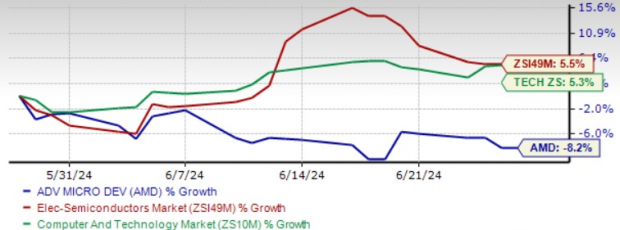Advanced Micro Devices AMD shares have faced an 8% decline in the past month, trailing behind the Zacks Electronics-Semiconductors industry’s 5.4% gain and the broader Zacks Computer & Technology sector’s 5% return. Contrastingly, its competitor NVIDIA NVDA has observed an 11% upward trend during the same timeframe.
Both AMD and NVDA have long been the investing darlings, benefitting from the surge in artificial intelligence (AI) applications, prompting a heightened demand for GPU chips to fuel AI models.
Nevertheless, recent market dynamics have shifted, with investors turning wary of AI chip providers due to a challenging macroeconomic scenario and mounting uncertainty surrounding the upcoming Presidential elections. These factors have cast a shadow on chip providers’ stock prices.
AMD, being smaller in size and possessing a lesser GPU market share than NVIDIA, has been particularly vulnerable to this trend. Despite boasting a strong product portfolio, increasing doubts about its ability to challenge NVIDIA, at least in the immediate future, have weighed on its stock performance.
Evaluating the Last Month’s Performance of AMD Stock

Image Source: Zacks Investment Research
Nonetheless, the drop in AMD’s share price may present opportunities for investors willing to take risks. The AI sector is predicted to stay robust, with major cloud computing players like Microsoft MSFT and Alphabet GOOGL ramping up their investments.
Gartner anticipates a 19.1% CAGR in AI software spending from 2022 to 2027, reaching $297 billion in 2027. Spending on Generative AI (GenAI) software is forecasted to surge from 8% in 2023 to 35% by 2027. Deloitte projects that enterprise spending on GenAI will climb 30% in 2024 from $16 billion in 2023.
AMD’s strategic moves to expand its product range position it favorably to compete with NVDA not only in the data center sphere but also in the expanding AI-driven consumer PC market in the long run.
AMD’s Strong Portfolio Nurtures Long-Term Growth
At Computex 2024, AMD introduced its Instinct accelerator roadmap, featuring the upcoming Instinct MI325X accelerator slated for release in the fourth quarter of 2024.
The forthcoming CDNA 4 architecture in 2025 is set to power the AMD Instinct MI350 Series, expected to deliver up to 35X enhanced AI inference performance in comparison to the AMD Instinct MI300 Series with AMD CDNA 3. The CDNA “Next” architecture will fuel the anticipated MI400 series accelerators in 2026.
AMD rolled out the fifth generation of EPYC server processors (Turin) utilizing the Zen 5 core. It further expanded its lineup with the debut of the Ryzen AI 300 Series, the third iteration of AMD AI-enabled mobile processors, and the Ryzen 9000 Series processors for laptop and desktop PCs.
AMD is reaping the benefits of its robust partner network. During Computex, Microsoft, HP, Lenovo, and Asus unveiled new PCs empowered by third-gen AMD Ryzen AI 300 Series processors and AMD Ryzen 9000 Series desktop processors.
Increased Competition Poses Challenges for AMD
NVIDIA’s decision to launch new AI chip models annually rather than the previous biennial update cycle intensifies the competitive landscape for AMD. Moreover, endeavors by tech giants such as Microsoft, Alphabet, and Meta Platforms to construct their own AI platforms do not augur well for AMD.
Microsoft’s Maia 100 AI accelerator excels in handling cloud AI workloads like extensive language model training and inference. It operates on a 5-nanometer TSMC process and comprises 105 billion transistors.
Alphabet’s Google unveiled the Axion central processing unit (CPU) to support its AI operations in data centers. The Axion processors mark the tech giant’s debut in Arm-based CPUs designed for efficient performance and energy usage.
Meta Training and Inference Accelerator, a range of tailored chips by Meta for its AI tasks, supports novel generative AI products and services, recommendation systems, and advanced AI research.
Analyzing AMD Stock’s Value Proposition
AMD stock, while trading at a discount relative to NVIDIA and marginally above the Zacks Electronics – Semiconductors industry, bears a forward 12-month P/E of 36.84X, lower than NVIDIA’s 43X but slightly higher than the industry’s 34.83X.
However, this may not be compelling for growth-oriented investors in the short term, given the modest growth prospects of this Zacks Rank #3 (Hold) entity. The second quarter of 2024 revenue projections for AMD stand at $5.7 billion (+/-$300 million), indicating approximately 6% year-over-year growth at the midpoint of the revenue range and around 4% sequential growth.
The Zacks Consensus Estimate for second-quarter 2024 revenues is $5.71 billion, reflecting a 6.54% growth year over year. Earnings per share estimate is pegged at 66 cents, a slight dip from the figures of the past month.





